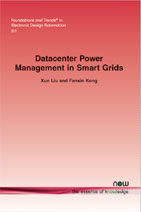Datacenter Power Management in Smart Grids
By Xue Liu, McGill University, Montreal, Canada, xueliu@cs.mcgill.ca | Fanxin Kong, McGill University, Montreal, Canada, fanxin.kong@mail.mcgill.ca
Abstract
Cloud computing is a new computing paradigm and it is gaining wide popularity due to its benefits including reduced cost, ease of management, and increased reliability. In a cloud computing environment, companies or individuals offload their computing (hardware/software/data) to the cloud, which is supported by the computing infrastructure called datacenters. Datacenters consume large amounts of electricity to operate and bring enormous electricity bills to the operators. Associated carbon emissions from operating datacenters also cause significant negative impact to the environment. In the mean time, a new kind of electrical grid, called the smart grid, is emerging. Smart grids enable two way communications between the power generators and the power consumers. Smart grid technology brings many salient features to help deliver power efficiently and reliably. There are many research efforts addressing either of the two tracks above. Different with them, we consider both and focus on cost-aware datacenter power management in presence of smart grids. We review recent developments on this area in this article. It involves understanding how a smart grid operates, where power goes in datacenters, and most importantly, how to reduce the power cost and/or negative environmental impact when operating datacenters.
Datacenter Power Management in Smart Grids
Datacenter Power Management in Smart Grids overviews recent work on managing and minimizing the cost of data centers in the context of smart grids. It starts by reviewing the operation of smart grids and analyzing how power is consumed in datacenters. Then, it presents various cost minimization approaches using techniques from the fields of optimization, algorithmics, and feedback control. In particular, it focuses on approaches that utilize time-of-use pricing and demand response features to cut the datacenter electricity cost.
In a cloud computing environment, companies or individuals offload their computing to the cloud, which is supported by the computing infrastructure called datacenters. The operation of these datacenters consumes large amounts of electricity, bringing high costs and negatively impacting the environment. In the mean time, a new kind of electrical grid, the smart grid, is emerging. Smart grids enable two-way communications between the power generators and the power consumers. Smart grid technology brings many salient features to help deliver power efficiently and reliably. While a lot of research has been conducted on both datacenters and smart grids, Datacenter Power Management in Smart Grids takes the novel approach of considering both together and focuses on cost-aware datacenter power management in the presence of smart grids. This work reviews recent developments in this area and explains how a smart grid operates, where power goes in datacenters, and, most importantly, how to reduce the power cost and/or negative environmental impact when operating datacenters.
